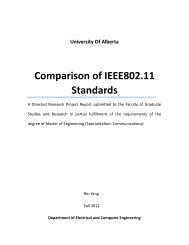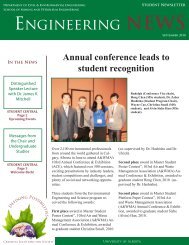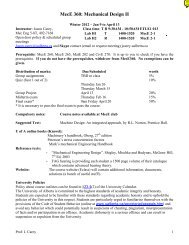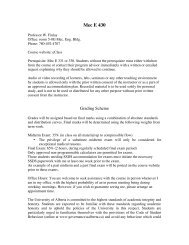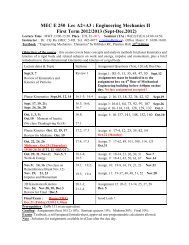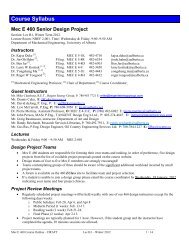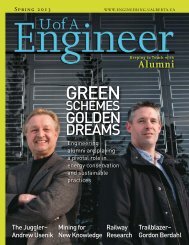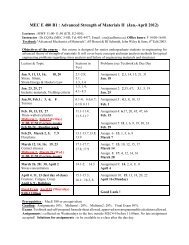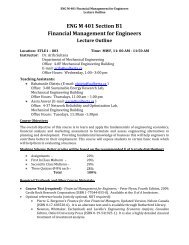Download - Faculty of Engineering - University of Alberta
Download - Faculty of Engineering - University of Alberta
Download - Faculty of Engineering - University of Alberta
Create successful ePaper yourself
Turn your PDF publications into a flip-book with our unique Google optimized e-Paper software.
Drs. Donald Robinson and Ding-Yu Peng<br />
made an enduring contribution to their<br />
pr<strong>of</strong>ession and the oil and gas industry<br />
through the equation that bears their name.<br />
Associates, the technology company he<br />
founded in Edmonton.<br />
“Don had many interests and excelled at<br />
them all,” says Otto. “In particular, he<br />
excelled in his chosen field <strong>of</strong> chemical engineering<br />
as an educator, researcher, businessman,<br />
and entrepreneur.”<br />
Robinson was born in Calgary, and raised<br />
in B.C.’s Okanagan Valley. He obtained his<br />
BSc and MSc in chemical engineering from the<br />
<strong>University</strong> <strong>of</strong> British Columbia and his PhD<br />
from the <strong>University</strong> <strong>of</strong> Michigan. His mentor<br />
at Michigan was Dr. Donald Katz, a world<br />
leader in natural gas and gas processing<br />
equipment, and the educator <strong>of</strong> many technological<br />
leaders in this field.<br />
Robinson’s PhD focused on heat transfer,<br />
but his time at Michigan kindled a new<br />
enthusiasm for phase behaviour. This passion<br />
led to the Peng-Robinson EOS.<br />
Robinson’s association with the U <strong>of</strong> A<br />
began in 1948, when he was hired as an assistant<br />
pr<strong>of</strong>essor. He went on to become an<br />
associate and full pr<strong>of</strong>essor, and the head <strong>of</strong><br />
Chemical and Petroleum <strong>Engineering</strong> from<br />
1959 to 1970. “Many classes <strong>of</strong> students recognized<br />
his ability to present technical material<br />
in an understandable way, and fondly<br />
regard him for the quality <strong>of</strong> his contribution<br />
to their education,” says Otto.<br />
Besides teaching thousands <strong>of</strong> undergrads,<br />
Robinson also contributed to the bricks and<br />
mortar <strong>of</strong> the university. He advocated for and<br />
Photo courtesy Schlumberger DBR Technology Centre<br />
helped design a new building with expanded<br />
facilities for Chemical <strong>Engineering</strong> in the<br />
1960s. During the same decade, he led the formation<br />
<strong>of</strong> the Canadian Society for Chemical<br />
<strong>Engineering</strong> and became deeply involved with<br />
the U.S.-based Gas Processing Association<br />
(GPA). Both organizations, as well as APEGGA<br />
and the <strong>Alberta</strong> government, gave him awards.<br />
The GPA provided one <strong>of</strong> Robinson’s proudest<br />
moments, by awarding him the newly minted<br />
Donald L. Katz Award in 1986. (Five other<br />
Canadians have subsequently received this<br />
award and all were significantly influenced by<br />
their association with Robinson.)<br />
In 1970, Robinson stepped down as<br />
department chair to focus on teaching and<br />
research. He attracted top-flight people from<br />
around the world as research associates, and<br />
mentored the work <strong>of</strong> 27 graduate students,<br />
many <strong>of</strong> whom have made their own marks in<br />
science, technology, and education.<br />
Robinson’s work resulted in the publication<br />
<strong>of</strong> 190 research papers and reports.<br />
Robinson began his own engineering company<br />
in 1980, DBR & Associates, to provide<br />
technology transfer initiatives based on U <strong>of</strong> A<br />
research work. The company evolved to provide<br />
three primary business services: specialized<br />
laboratory and research services (with an<br />
emphasis on phase behaviour and specialized<br />
fluid property measurements), the design and<br />
manufacture <strong>of</strong> high-pressure laboratory equipment<br />
and specialty s<strong>of</strong>tware products, and engineering<br />
and technology consulting services.<br />
A 1985 Edmonton Journal article on DBR<br />
extolled Robinson’s leadership. “Robinson<br />
himself is recognized as one <strong>of</strong> the world’s<br />
foremost authorities on the behaviour <strong>of</strong> oil<br />
and gas when it is being produced, transported<br />
or processed into petrochemicals.”<br />
Those who knew Robinson as family,<br />
friend, teacher, faculty colleague, or businessman<br />
also appreciate his personal qualities.<br />
As Dr. Otto said in his 1998 eulogy for<br />
Robinson, “Life for him was always full<br />
to the brim and he loved every minute <strong>of</strong><br />
it. He treasured his family and had many<br />
interests outside <strong>of</strong> his engineering work. He<br />
was admired and respected by all he touched<br />
with his genuine interest, bubbly enthusiasm,<br />
competence, fairness, pr<strong>of</strong>essionalism, and<br />
wise counsel.”<br />
Robinson remained the president <strong>of</strong> DBR<br />
until 1989, chair <strong>of</strong> the board until 1993, and<br />
a board member until his death in 1998. DBR<br />
has now been absorbed into the international<br />
conglomerate Schlumberger but retains the<br />
core activities and name <strong>of</strong> its predecessor.<br />
In 2006, the Schlumberger DBR Technology<br />
Centre in Edmonton honoured Robinson’s<br />
memory with a 30th anniversary celebration <strong>of</strong><br />
the Peng-Robinson Equation <strong>of</strong> State.<br />
Now widely used, and cited in more than<br />
2,600 published works, the Peng-Robinson<br />
EOS continues to enhance the work <strong>of</strong><br />
researchers and engineers in the petroleum<br />
field world around the globe, as does<br />
Robinson’s other research and development<br />
work. For example, one <strong>of</strong> Robinson’s former<br />
research associates, Dr. Heng-Joo Ng (MSc<br />
Chemical ’71, PhD Chemical ’75), who works<br />
at the DBR Centre, is considered a world<br />
expert on hydrates, a potential new energy<br />
source under investigation in the Mackenzie<br />
Delta and other areas <strong>of</strong> extreme cold.<br />
“Robinson himself is recognized as one<br />
<strong>of</strong> the world’s foremost authorities on<br />
the behaviour <strong>of</strong> oil and gas when it is<br />
being produced, transported or<br />
processed into petrochemicals.”<br />
—EDMONTON JOURNAL<br />
Robinson’s legacy lives on through the<br />
memories <strong>of</strong> former students, research associates,<br />
and faculty who knew him—and through<br />
the four scholarships and endowments <strong>of</strong>fered<br />
in his name: D. B. Robinson Undergraduate<br />
Thermodynamics Prize Fund, D. B. Robinson<br />
Research and Environmental <strong>Engineering</strong><br />
Fund, D. B. Robinson Graduate Chemical<br />
<strong>Engineering</strong> Scholarship, and D.B. Robinson<br />
Chemical <strong>Engineering</strong> Initiatives Endowment<br />
Fund. For information on ways to support any<br />
<strong>of</strong> these funds in honour <strong>of</strong> Dr. Robinson<br />
please contact Leanne Nickel at 780.492.4159<br />
or via e-mail at leanne.nickel@ualberta.ca.<br />
(With files from Richard Cairney)<br />
Andrea Collins is an Edmontonbased<br />
freelance writer and public<br />
relations consultant.<br />
Spring 2009 U <strong>of</strong> A Engineer 35




